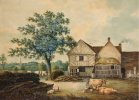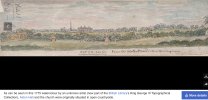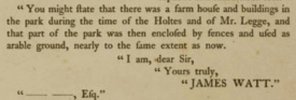-
Welcome to this forum . We are a worldwide group with a common interest in Birmingham and its history. While here, please follow a few simple rules. We ask that you respect other members, thank those who have helped you and please keep your contributions on-topic with the thread.
We do hope you enjoy your visit. BHF Admin Team
You are using an out of date browser. It may not display this or other websites correctly.
You should upgrade or use an alternative browser.
You should upgrade or use an alternative browser.
Farm near Aston Hall
- Thread starter Vivienne14
- Start date
What happened to that over grown graveyard where we played war hide and seekIf the Spire in the picture is that of Aston Parish Church then it stands on the right hand side of the bulk of the Church. Here is a Google picture of the Church from Wilton Lane on the S side.
View attachment 194868
Dinger
master brummie
Agreed, It's going to be either just to the South of the River Tame - maybe around where Village Road is now, or just the other side of the river where the Aston Villa Academy is now. That area was built over even in the oldest map I can find. (1830). There was a Witton Farm along that line of sight, but it looks much too far away to be the building in question unless the artist took liberties with the perspective.Assuming that there's no poetic license then with the position of the church and Aston Hall then it must have been to the north of the church. Difficult to say how far north, maybe between the river Tame and the church?
Lady Penelope
master brummie
The Medical Officer’s Report for 1898 stated that “in the June quarter two cases of Diphtheria (one fatal) were notified. In the one case (non-fatal) the origin of the disease could not be discovered, but the other occurred at Tyburn on the edge of the Sewage Farm, in one of the cottages belonging to the Drainage Board. This, I have no doubt, was due to the condition of this part of the Farm, which for many months was in a very unsatisfactory state. In the September quarter, five cases, two fatal, were reported, and four of these were in close propinquity to the Sewage Farm, and I have little doubt that they were due to its insanitary condition.”
Is this the Sewage Farm shown on the 1889 OS Map below ?
View attachment 178126
Hi Viv, do you know anything about the artist. The only Joseph Wright I've come across so far is Joseph Wright of Derby.A painting of a farmyard near Aston Hall by Joseph Wright (c18th century). The buildings look to be Tudor, but where exactly was it ? On the Aston Hall estate? Can we locate it from the church position and Aston Hall in the distance ?
View attachment 194867
Also, does anyone have a map of the original extent of Aston Park. I remember being surprised that it was so much larger than it is now and stretched as far as Walsall Road.
A Sparks
master brummie
Re the Joseph Wright who painted the picture of Aston Hall, I wondered about him too and looked to see if I could find some information but, as you say, the artist of the same name from Derby is the one that keeps coming up.Hi Viv, do you know anything about the artist. The only Joseph Wright I've come across so far is Joseph Wright of Derby.
Also, does anyone have a map of the original extent of Aston Park. I remember being surprised that it was so much larger than it is now and stretched as far as Walsall Road.
I don't think it's the same person as the style of his painting was very different.
A Sparks
master brummie
This is the only thing I can find that would refer to our Aston Hall man. .
Thanks. In that link, the artist dates given are 1756-93. Shall do some more searching
Last edited:
The Joseph Wright of Derby was born 1734 and died 1797. The link to Birmingham/surrounding areas could be with his contemporaries of the Lunar Society. So he must have spent time around the area. I wondered if he'd stayed at Aston Hall at some point ? If so, Hall would still have been in the possession of the Holte family. Doesn't prove anything as such though !!
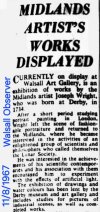
Source: British Newspaper Archive

Source: British Newspaper Archive
Last edited:
the painting on post 1 has been discussed on below thread..see post 72
lyn
could be lozells farm mike even taking into account the artistic license but my feeling is its too close to aston church as lozells farm was on the lozells road i think...mind you i could be wrong...lovely painting thoughThe house is in front of the church.. So could it be Lozells Farm, which would be in that sort of direction. It was (https://birminghamhistory.co.uk/forum/threads/lozells-farm.31492/) on the corner of Lozells Road and Lozells St. . Other paintings look different, but this one was probably older.
lyn
Thanks Lyn. I can see why Pedrocut posted the same painting on the Aston Church thread as the title seems to focus on Aston Church and Aston Hall. The one I posted on this thread indicated the main painting subject was the farm. So between us we're covering all bases ! Shall put a cross reference to the farm discussion on the Aston Church thread.
Last edited:
Lady Penelope
master brummie
Yes, I was totally confused as I knew I'd posted something about this painting! Thought it was another marble gone...
Britain's Lost Masterpieces featured a painting of Joseph Wright of Derby showing an Italian Bridge. It was in a style very different to the paintings that we usually know. It was housed in their 'Not Quite Wright' section. Well worth seeing on iplayer if you missed it.

One of the things they picked up on was the pink clouds, also seen in the farm painting. Might be wishful thinking.
Britain's Lost Masterpieces featured a painting of Joseph Wright of Derby showing an Italian Bridge. It was in a style very different to the paintings that we usually know. It was housed in their 'Not Quite Wright' section. Well worth seeing on iplayer if you missed it.

One of the things they picked up on was the pink clouds, also seen in the farm painting. Might be wishful thinking.
Richard Dye
master brummie
Very nice piece of art.............Yes, I was totally confused as I knew I'd posted something about this painting! Thought it was another marble gone...
Britain's Lost Masterpieces featured a painting of Joseph Wright of Derby showing an Italian Bridge. It was in a style very different to the paintings that we usually know. It was housed in their 'Not Quite Wright' section. Well worth seeing on iplayer if you missed it.
View attachment 204411
One of the things they picked up on was the pink clouds, also seen in the farm painting. Might be wishful thinking.
Following through on Dingers, LadyP's and Pedrocut's suggestions/discussion of the farm being in the Witton direction, it does look quite likely to be Witton Farm (as per Dinger's post #6). I've rotated maps to show the farm in relation to the Church and Aston Hall. This puts the church spire in the position as shown in the painting. The farm would have been between Cheshire Road and Wyrley Road (blue line)
The late Bill Dargue states and, specifically mentions Witton Farm; Twenty farms are known to have existed in Witton in 1730; Witton Farm lay between Cheshire Road and Wyrley Road.
He also stated about the placename 'Witton':
the name may originate from the Anglo-Saxon, wic tun meaning 'dairy farm', probably the outpost of a mother farm or village elsewhere, possibly Aston
The painting certainly suggests a dairy farm. I'm also attaching a press cutting from 1832 describing it as belonging to Mr Vyse who had the farm as a 'dairy establishment' . Wonder what constituted a 'capital Dwelling House' in 1832 ? Sadly, there are no specifics about the house itself to help pin this down.
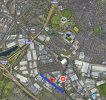
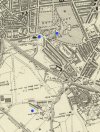
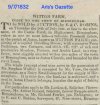
Source: British Newspaper Archive
The late Bill Dargue states and, specifically mentions Witton Farm; Twenty farms are known to have existed in Witton in 1730; Witton Farm lay between Cheshire Road and Wyrley Road.
He also stated about the placename 'Witton':
the name may originate from the Anglo-Saxon, wic tun meaning 'dairy farm', probably the outpost of a mother farm or village elsewhere, possibly Aston
The painting certainly suggests a dairy farm. I'm also attaching a press cutting from 1832 describing it as belonging to Mr Vyse who had the farm as a 'dairy establishment' . Wonder what constituted a 'capital Dwelling House' in 1832 ? Sadly, there are no specifics about the house itself to help pin this down.



Source: British Newspaper Archive
Last edited:
Lady Penelope
master brummie
Well researched Viv.
As always, helped by members Pen. Thank you.

